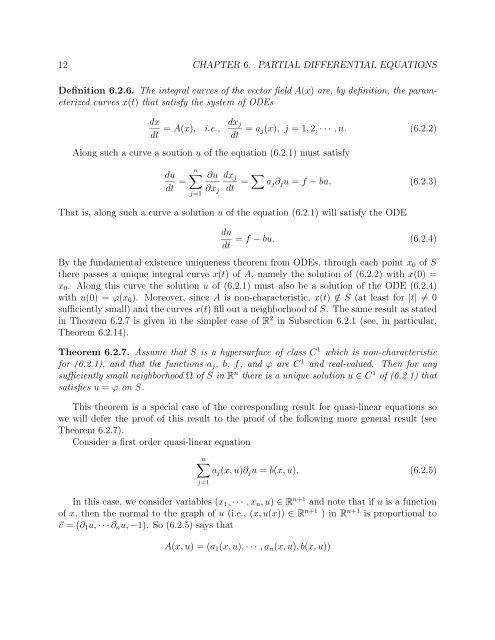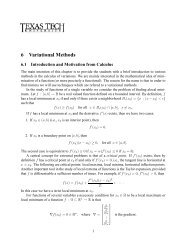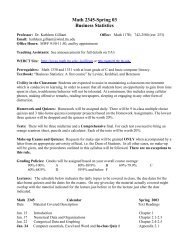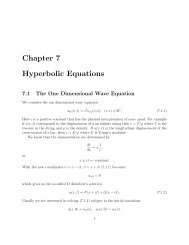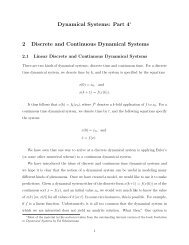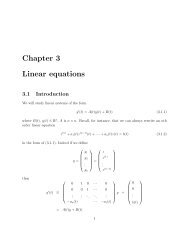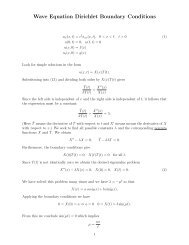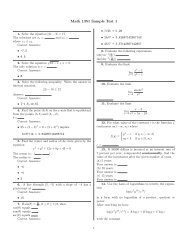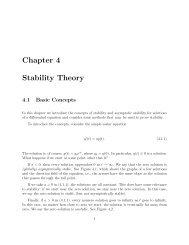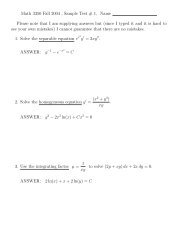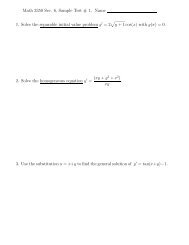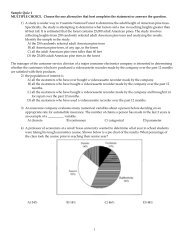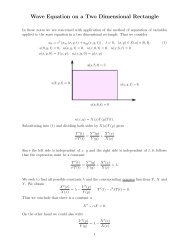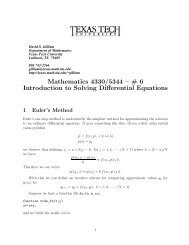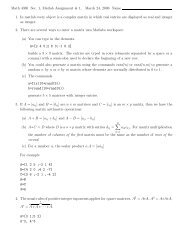Chapter 6 Partial Differential Equations
Chapter 6 Partial Differential Equations
Chapter 6 Partial Differential Equations
You also want an ePaper? Increase the reach of your titles
YUMPU automatically turns print PDFs into web optimized ePapers that Google loves.
12 CHAPTER 6. PARTIAL DIFFERENTIAL EQUATIONS<br />
Definition 6.2.6. The integral curves of the vector field A(x) are, by definition, the parameterized<br />
curves x(t) that satisfy the system of ODEs<br />
dx<br />
dt = A(x), i.e., dx j<br />
dt = a j(x), j =1, 2, ··· ,n. (6.2.2)<br />
Along such a curve a soution u of the equation (6.2.1) must satisfy<br />
du<br />
dt =<br />
n∑<br />
j=1<br />
∂u<br />
∂x j<br />
dx j<br />
dt = ∑ a j ∂ j u = f − bu. (6.2.3)<br />
That is, along such a curve a solution u of the equation (6.2.1) will satisfy the ODE<br />
du<br />
= f − bu. (6.2.4)<br />
dt<br />
By the fundamental existence uniqueness theorem from ODEs, through each point x 0 of S<br />
there passes a unique integral curve x(t) ofA, namely the solution of (6.2.2) with x(0) =<br />
x 0 . Along this curve the solution u of (6.2.1) must also be a solution of the ODE (6.2.4)<br />
with u(0) = ϕ(x 0 ). Moreover, since A is non-characteristic, x(t) ∉ S (at least for |t| ≠0<br />
sufficiently small) and the curves x(t) fill out a neighborhood of S. The same result as stated<br />
in Theorem 6.2.7 is given in the simpler case of R 2 in Subsection 6.2.1 (see, in particular,<br />
Theorem 6.2.14).<br />
Theorem 6.2.7. Assume that S is a hypersurface of class C 1 which is non-characteristic<br />
for (6.2.1), and that the functions a j , b, f, and ϕ are C 1 and real-valued. Then for any<br />
sufficiently small neighborhood Ω of S in R n there is a unique solution u ∈ C 1 of (6.2.1) that<br />
satisfies u = ϕ on S.<br />
This theorem is a special case of the corresponding result for quasi-linear equations so<br />
we will defer the proof of this result to the proof of the following more general result (see<br />
Theorem 6.2.7).<br />
Consider a first order quasi-linear equation<br />
n∑<br />
a j (x, u)∂ j u = b(x, u). (6.2.5)<br />
j=1<br />
In this case, we consider variables (x 1 , ··· ,x n ,u) ∈ R n+1 and note that if u is a function<br />
of x, then the normal to the graph of u (i.e., (x, u(x)) ∈ R n+1 )inR n+1 is proportional to<br />
⃗v =(∂ 1 u, ···∂ n u, −1). So (6.2.5) says that<br />
A(x, u) =(a 1 (x, u), ··· ,a n (x, u),b(x, u))


